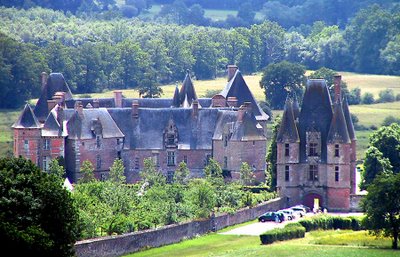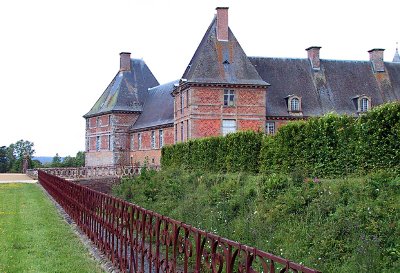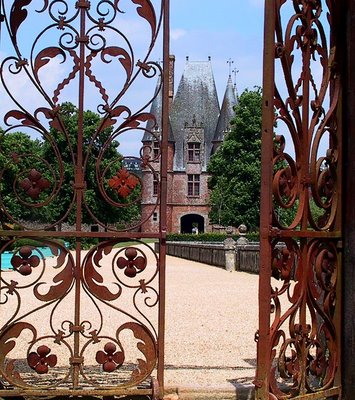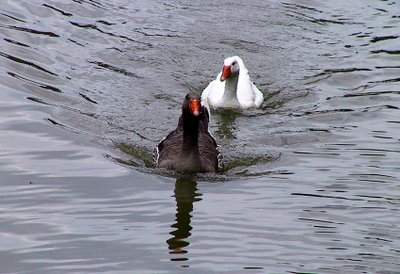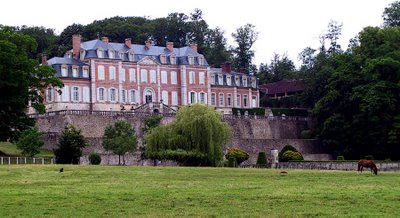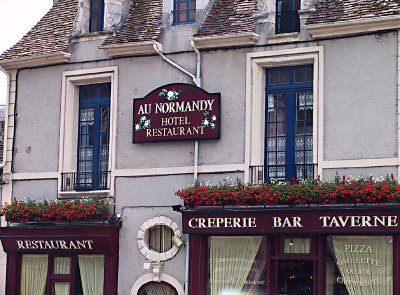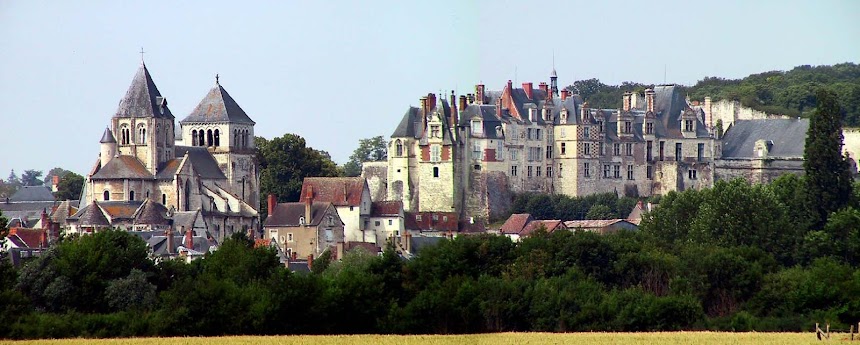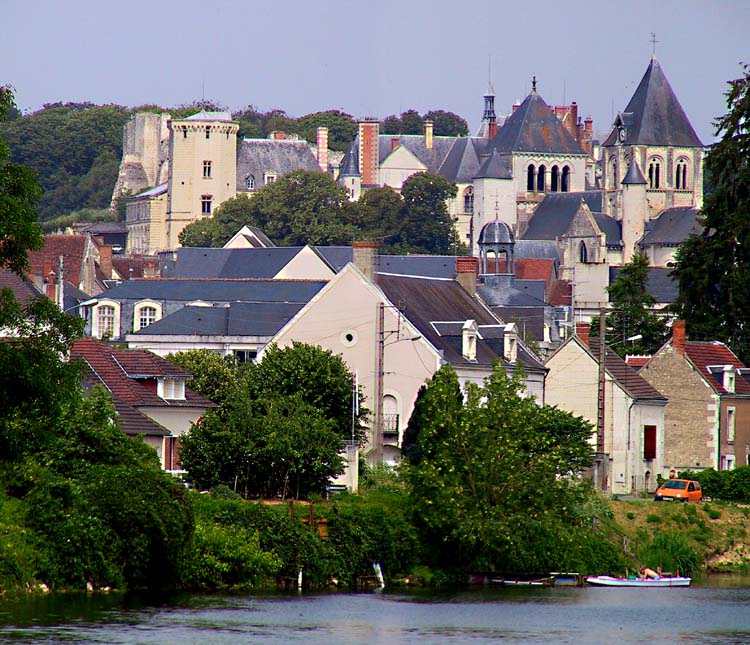A few days back I posted a picture of the famous cheese tray served at the Restaurant Astier in the 11th arrondissement in Paris.
Did I mention that our waiter was a comedian and entertainer? First he balanced a chair on his chin.
Then he balanced a knife on his nose.
He didn't know an awful lot about the wines we ordered or the cheeses on the tray, but he was efficient in his service and entertaining in his tricks.
Here we are enjoying our evening of good food, good wine, good company, and good entertainment.
27 June 2006
25 June 2006
Bagnoles, a spa town

Bagnoles-de-l'Orne is a spa town located not too far west of Alençon. It's a surprising place, or at least it was to me. I didn't know there were thermes — hot springs — in Normandy. And I didn't know there were these kinds of resort towns up there.
People, especially older people, go to places like Bagnoles to "take the waters." They bathe in the hot springs and if they're lucky their arthritis and rhumatism pains go away. Among other maladies, I guess.
Something about the place reminded me of what a resort in Switzerland might be like, even though Bagnoles is not in the mountains. There are however some high hills in this part of Normandy, and the landscape is very green.
Needless to say, there are a lot of senior citizens in Bagnoles. It's a quiet, peaceful, calm kind of place. I felt like I fit right in (my age: 57), and I'm going to keep the place in mind as the years continue to pile up (better than the alternative, they say).
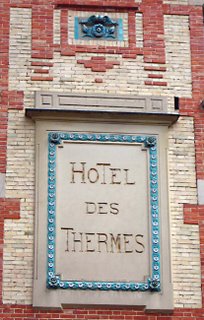 And Bagnoles is full of hotels. I looked at the room rates posted in one and was at first surprised to see that it offered chambres avec eau courante — rooms with running water — for €22 a night.
And Bagnoles is full of hotels. I looked at the room rates posted in one and was at first surprised to see that it offered chambres avec eau courante — rooms with running water — for €22 a night.I guess if you're taking the waters by bathing in the hot springs every day, you don't really need a bathroom in your hotel room. The toilet is probably down the hall. This particular hotel also offered rooms with baths and showers, but at twice the price.
"Hot Springs Hotel"

This hotel called Le Roc au Chien (Dog Rock) is located on the little road that goes from the baths at Bagnoles back into the center of the little town. It's a short walk, actually. The building is nice.
 There are so many hotels in Bagnoles de l'Orne! Every other building is a hotel, and some of them are enormous. You can find whatever style of hotel you would ever want, from modern and luxurious to old-fashioned and inexpensive. Here are two more, right in the middle of town.
There are so many hotels in Bagnoles de l'Orne! Every other building is a hotel, and some of them are enormous. You can find whatever style of hotel you would ever want, from modern and luxurious to old-fashioned and inexpensive. Here are two more, right in the middle of town. Bagnoles-de-l'Orne would be a great place to stay
Bagnoles-de-l'Orne would be a great place to stayfor somebody wanting to visit the surrounding area,
including Sées, Carrouges, and the hilltop town of Domfront.
And finally in the middle of the town there's a lake and on the edge of the lake a casino. If you get the low-price room in one of the hotels you'll have some money left over for gambling. I just hope you don't end up taking a bath at the casino, if you see what I mean.
Le château de Carrouges (and others nearby)
Carrouges is a village located about 30 km/18 mi northwest of the town of Alençon in Normandy. That puts it about 180 km/110 mi west and slightly south of Paris. Other towns near Carrouges are the spa called Bagnoles de l'Orne and the hilltop walled town of Domfront. Le Mans, Chartres, and the Normandy coast are all within easy driving distance.
The main attraction at Carrouges (pop. 800 or so) is an immense château that dates back to the 12th century. The red-brick buildings are surrounded by a 25-acre park.
At Carrouges you are free to stroll around the grounds of the château. The main building is surrounded by a moat that is full of fish and has geese and ducks swimming on it. Guided tours of the interior of the château are available, but it wasn't convenient for us to take one.
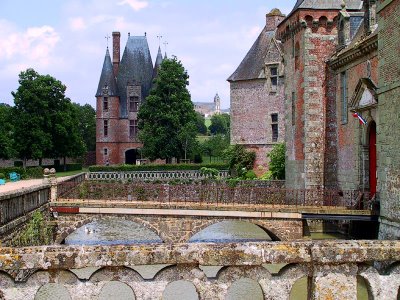 The moat with the gatehouse in the background. In the distance,
The moat with the gatehouse in the background. In the distance,
you can see the church located in the village of Carrouges.
The Michelin guide describes the château de Carrouges as "austere" and "imposing." The buildings that remain today were built mainly during the reigns of Henri IV and Louis XIII, between 1590 and 1630. There is, however, a bedroom called La Chambre de Louis XI, named for the king by that name who visited on August 11, 1473.
One of the things I especially enjoyed about wandering around the grounds at Carrouges was seeing all the animals living there. In the moat there were geese and ducks, along with large schools of fat carp.
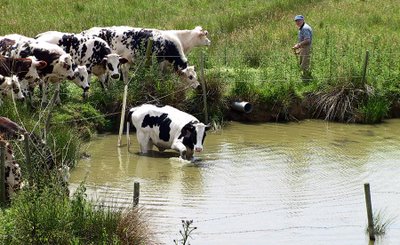 Very near the château, I saw this small herd of cattle and
Very near the château, I saw this small herd of cattle and
a man cutting weeds with a sickle. One of the bovines decided
to go for a swim and was soon joined by others.
There are two other châteaux within 10 miles of Carrouges. One is the Château d'O, a moated structures that Michelin describes as "a highly original example of the fantasy employed by early Renaissance Norman architects." It was owned for many years by the O family, aristocrats who were close advisers and confidants of several French kings.
Also nearby is the 18th century Château de Sassy, with intricate formal gardens and wide terraces.
The main attraction at Carrouges (pop. 800 or so) is an immense château that dates back to the 12th century. The red-brick buildings are surrounded by a 25-acre park.
At Carrouges you are free to stroll around the grounds of the château. The main building is surrounded by a moat that is full of fish and has geese and ducks swimming on it. Guided tours of the interior of the château are available, but it wasn't convenient for us to take one.
 The moat with the gatehouse in the background. In the distance,
The moat with the gatehouse in the background. In the distance,you can see the church located in the village of Carrouges.
The Michelin guide describes the château de Carrouges as "austere" and "imposing." The buildings that remain today were built mainly during the reigns of Henri IV and Louis XIII, between 1590 and 1630. There is, however, a bedroom called La Chambre de Louis XI, named for the king by that name who visited on August 11, 1473.
One of the things I especially enjoyed about wandering around the grounds at Carrouges was seeing all the animals living there. In the moat there were geese and ducks, along with large schools of fat carp.
 Very near the château, I saw this small herd of cattle and
Very near the château, I saw this small herd of cattle anda man cutting weeds with a sickle. One of the bovines decided
to go for a swim and was soon joined by others.
* * *
There are two other châteaux within 10 miles of Carrouges. One is the Château d'O, a moated structures that Michelin describes as "a highly original example of the fantasy employed by early Renaissance Norman architects." It was owned for many years by the O family, aristocrats who were close advisers and confidants of several French kings.
Also nearby is the 18th century Château de Sassy, with intricate formal gardens and wide terraces.
23 June 2006
Sées in Normandy
On Monday morning we hit the road with our friend Sue about 9:30 and headed up toward Normandy in the Peugeot. First we drove over to Tours on local roads, and there we picked up the autoroute that now is open from Tours to Rouen, passing near Le Mans and the big Norman town called Alençon along the way. We ourselves were headed not to Rouen, but west to the Mont-Saint-Michel along little roads from the little town of Sées.
At about noon, we arrived in Sées (pop. 4,500), just north of Alençon. In Sées there is an enormous gothic cathedral and there are several religious communities and two seminaries. The Michelin Green Guide describes Sées as a "quiet old cathedral town" and its cathedral as "one of the finest examples of 13C and 14C Norman Gothic."
north of Alençon. In Sées there is an enormous gothic cathedral and there are several religious communities and two seminaries. The Michelin Green Guide describes Sées as a "quiet old cathedral town" and its cathedral as "one of the finest examples of 13C and 14C Norman Gothic."
The Michelin guide also points out that there are "magnificent" 13th-century stained glass windows in the Sées cathedral, but the windows were placed too high up in the walls for me to be able to photograph them well.
 We stopped in Sées to see the cathedral of course (So what did Sue see in Sées? You say Sue saw the church in Sées?) but we also needed to stop in a supermarket to buy some sandwich bread for the picnic lunch we were planning to have out in the country near, we hoped, one of the local châteaus -- the Château d'O, the Château de Sassy, and the Château de Carrouges.
We stopped in Sées to see the cathedral of course (So what did Sue see in Sées? You say Sue saw the church in Sées?) but we also needed to stop in a supermarket to buy some sandwich bread for the picnic lunch we were planning to have out in the country near, we hoped, one of the local châteaus -- the Château d'O, the Château de Sassy, and the Château de Carrouges.
Sées was anything but quiet when we arrived on the main square just after noon. It was full of British people who had arrived in sports cars and were noisily drinking beer and whooping it up in the sidewalk cafés. We had seen the sports cars on the autoroute between Le Mans and Alençon. It turns out that the big 24-hour Le Mans automobile race had taken place over the weekend, and all these British people were leaving via autoroute to return to the U.K.
It started as we were driving along at the speed limit, 130 kph/80 mph. Suddenly we were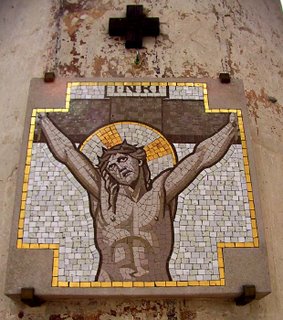 passed by a line of sports cars with British licence plates on them and drivers sitting on the "wrong" side of the car. There were Porsches, Maseratis, Ferraris, Audis, BMWs, and little English cars we didn't recognize, and they were all driving at about 100 miles an hour. There were several dozen British cars in the fast-moving caravan.
passed by a line of sports cars with British licence plates on them and drivers sitting on the "wrong" side of the car. There were Porsches, Maseratis, Ferraris, Audis, BMWs, and little English cars we didn't recognize, and they were all driving at about 100 miles an hour. There were several dozen British cars in the fast-moving caravan.
 When we left the autoroute at Sées, there were toll-takers stationed at each tollgate, even the ones where you normally pay by credit card. Walt leaned out the window and asked the young guy standing there in his electric green security vest if he knew why so many English people were on the road.
When we left the autoroute at Sées, there were toll-takers stationed at each tollgate, even the ones where you normally pay by credit card. Walt leaned out the window and asked the young guy standing there in his electric green security vest if he knew why so many English people were on the road.
"They're leaving Le Mans today after seeing the race and returning home. We're here because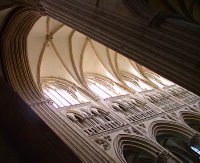 so many of them need to pay cash at the toll booth, and need help figuring out how to feed money into the machines," he said in French.
so many of them need to pay cash at the toll booth, and need help figuring out how to feed money into the machines," he said in French.
"They're driving fast," Walt said.
"Yes, a lot of them are being stopped by the gendarmes and escorted off the road," the French guy said. "One driver was clocked at 237 kph just a few minutes ago." 237 kph is 147 mph!
 Because Europe is not yet fully united and integrated and standard-
Because Europe is not yet fully united and integrated and standard-
ized, the problem of foreigners speeding on French highways is a difficult one for the French authorities. The gendarmes can stop a British or German car for speeding, but they can't put points on the foreign driver's license. I assume it's the same in all the EU countries. So foreign drivers can be required to pay a fine, but they can then leave the country and incur no further penalty for their reckless driving.
foreign driver's license. I assume it's the same in all the EU countries. So foreign drivers can be required to pay a fine, but they can then leave the country and incur no further penalty for their reckless driving.
I don't know why so many of the Brits had left the autoroute at Sées to have lunch. Maybe the crowd of enthusiasts who go to the Le Mans race know it is a good place to stop, with several cafés and restaurants on the main square, near the cathedral. Alençon, just a few miles south, is a much bigger town, and maybe a lot of other British race fans had stopped there too.
We spent some time taking pictures in and around the church, as you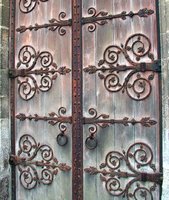 can see. We were successful in finding an Intermarché that was still open, but just barely. It was closing up for the two-hour lunch break when we arrived, but we were able to duck in and buy a loaf of sandwich bread and a bag of potato chips to fill out our lunch menu. We had quiche, lettuce, tomatoes, cheese, sliced ham, wine, and fruit juice in a cooler in the car.
can see. We were successful in finding an Intermarché that was still open, but just barely. It was closing up for the two-hour lunch break when we arrived, but we were able to duck in and buy a loaf of sandwich bread and a bag of potato chips to fill out our lunch menu. We had quiche, lettuce, tomatoes, cheese, sliced ham, wine, and fruit juice in a cooler in the car.
We drove on up to see the Château d'O, just north of Sées, but it was closed for lunch and there were no picnic tables in view. So we drove on to Sassy, but there were no picnic areas there either.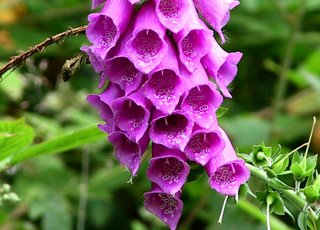 Finally, we turned off the main road that was taking us toward Carrouges and happened upon a picnic area along the side of a little road way out in the country. It was perfect, though it started raining just as we were finishing our lunch. You have to expect rain in Normandy, so all was going according to plan.
Finally, we turned off the main road that was taking us toward Carrouges and happened upon a picnic area along the side of a little road way out in the country. It was perfect, though it started raining just as we were finishing our lunch. You have to expect rain in Normandy, so all was going according to plan.
Next we would visit Carrouges...
At about noon, we arrived in Sées (pop. 4,500), just
 north of Alençon. In Sées there is an enormous gothic cathedral and there are several religious communities and two seminaries. The Michelin Green Guide describes Sées as a "quiet old cathedral town" and its cathedral as "one of the finest examples of 13C and 14C Norman Gothic."
north of Alençon. In Sées there is an enormous gothic cathedral and there are several religious communities and two seminaries. The Michelin Green Guide describes Sées as a "quiet old cathedral town" and its cathedral as "one of the finest examples of 13C and 14C Norman Gothic."The Michelin guide also points out that there are "magnificent" 13th-century stained glass windows in the Sées cathedral, but the windows were placed too high up in the walls for me to be able to photograph them well.
 We stopped in Sées to see the cathedral of course (So what did Sue see in Sées? You say Sue saw the church in Sées?) but we also needed to stop in a supermarket to buy some sandwich bread for the picnic lunch we were planning to have out in the country near, we hoped, one of the local châteaus -- the Château d'O, the Château de Sassy, and the Château de Carrouges.
We stopped in Sées to see the cathedral of course (So what did Sue see in Sées? You say Sue saw the church in Sées?) but we also needed to stop in a supermarket to buy some sandwich bread for the picnic lunch we were planning to have out in the country near, we hoped, one of the local châteaus -- the Château d'O, the Château de Sassy, and the Château de Carrouges.Sées was anything but quiet when we arrived on the main square just after noon. It was full of British people who had arrived in sports cars and were noisily drinking beer and whooping it up in the sidewalk cafés. We had seen the sports cars on the autoroute between Le Mans and Alençon. It turns out that the big 24-hour Le Mans automobile race had taken place over the weekend, and all these British people were leaving via autoroute to return to the U.K.
It started as we were driving along at the speed limit, 130 kph/80 mph. Suddenly we were
 passed by a line of sports cars with British licence plates on them and drivers sitting on the "wrong" side of the car. There were Porsches, Maseratis, Ferraris, Audis, BMWs, and little English cars we didn't recognize, and they were all driving at about 100 miles an hour. There were several dozen British cars in the fast-moving caravan.
passed by a line of sports cars with British licence plates on them and drivers sitting on the "wrong" side of the car. There were Porsches, Maseratis, Ferraris, Audis, BMWs, and little English cars we didn't recognize, and they were all driving at about 100 miles an hour. There were several dozen British cars in the fast-moving caravan. When we left the autoroute at Sées, there were toll-takers stationed at each tollgate, even the ones where you normally pay by credit card. Walt leaned out the window and asked the young guy standing there in his electric green security vest if he knew why so many English people were on the road.
When we left the autoroute at Sées, there were toll-takers stationed at each tollgate, even the ones where you normally pay by credit card. Walt leaned out the window and asked the young guy standing there in his electric green security vest if he knew why so many English people were on the road."They're leaving Le Mans today after seeing the race and returning home. We're here because
 so many of them need to pay cash at the toll booth, and need help figuring out how to feed money into the machines," he said in French.
so many of them need to pay cash at the toll booth, and need help figuring out how to feed money into the machines," he said in French."They're driving fast," Walt said.
"Yes, a lot of them are being stopped by the gendarmes and escorted off the road," the French guy said. "One driver was clocked at 237 kph just a few minutes ago." 237 kph is 147 mph!
 Because Europe is not yet fully united and integrated and standard-
Because Europe is not yet fully united and integrated and standard-ized, the problem of foreigners speeding on French highways is a difficult one for the French authorities. The gendarmes can stop a British or German car for speeding, but they can't put points on the
 foreign driver's license. I assume it's the same in all the EU countries. So foreign drivers can be required to pay a fine, but they can then leave the country and incur no further penalty for their reckless driving.
foreign driver's license. I assume it's the same in all the EU countries. So foreign drivers can be required to pay a fine, but they can then leave the country and incur no further penalty for their reckless driving.I don't know why so many of the Brits had left the autoroute at Sées to have lunch. Maybe the crowd of enthusiasts who go to the Le Mans race know it is a good place to stop, with several cafés and restaurants on the main square, near the cathedral. Alençon, just a few miles south, is a much bigger town, and maybe a lot of other British race fans had stopped there too.
We spent some time taking pictures in and around the church, as you
 can see. We were successful in finding an Intermarché that was still open, but just barely. It was closing up for the two-hour lunch break when we arrived, but we were able to duck in and buy a loaf of sandwich bread and a bag of potato chips to fill out our lunch menu. We had quiche, lettuce, tomatoes, cheese, sliced ham, wine, and fruit juice in a cooler in the car.
can see. We were successful in finding an Intermarché that was still open, but just barely. It was closing up for the two-hour lunch break when we arrived, but we were able to duck in and buy a loaf of sandwich bread and a bag of potato chips to fill out our lunch menu. We had quiche, lettuce, tomatoes, cheese, sliced ham, wine, and fruit juice in a cooler in the car.We drove on up to see the Château d'O, just north of Sées, but it was closed for lunch and there were no picnic tables in view. So we drove on to Sassy, but there were no picnic areas there either.
 Finally, we turned off the main road that was taking us toward Carrouges and happened upon a picnic area along the side of a little road way out in the country. It was perfect, though it started raining just as we were finishing our lunch. You have to expect rain in Normandy, so all was going according to plan.
Finally, we turned off the main road that was taking us toward Carrouges and happened upon a picnic area along the side of a little road way out in the country. It was perfect, though it started raining just as we were finishing our lunch. You have to expect rain in Normandy, so all was going according to plan.Next we would visit Carrouges...
19 June 2006
Gardening and cooking
One of the highlights of the year here is Saint-Aignan is the summer vegetable garden. Nearly everybody in the country has one, and many people who live in town have a garden on a plot of land, an allotment, made available by the municipality.
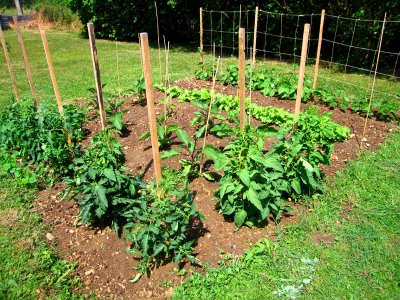 Our summer vegetable garden at La Renaudière in mid-June 2006.
Our summer vegetable garden at La Renaudière in mid-June 2006.
Here you see tomatoes, eggplants, mustard greens, and runner beans.
Gardening starts in March when the weather cooperates. People begin working the soil, either the old-fashioned way with shovel, hoe, and rake, or with more modern contraptions like rototillers. That's what we do. We invested in a gas-powered tiller three years ago after trying to dig in our heavy clay soil for a few weeks with a shovel. The rototiller makes it all possible.
The things we grow in our garden are not different from what you would grow nearly anywhere in the U.S. This year, we put in tomatoes (16 plants of different varieties, so we are going to have a ton of tomatoes to eat fresh, to freeze for later, and to give away to friends and neighbors), eggplants, red bell peppers, green runner beans (thanks to Janet and David for those seeds), cucumbers, yellow and green summer squash, and mustard greens ( a nod to my Southern heritage).
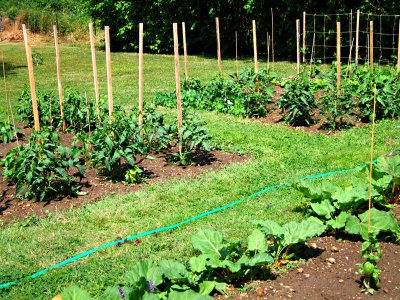 This picture shows parts of 3 of our 4 garden plots. You can see that
This picture shows parts of 3 of our 4 garden plots. You can see that
Walt has provided every plant with a heavy wooden stake for support.
The days here are long in June. The sun comes up at 6:30 a.m. and goes down around 10:00 p.m. The growing season begins May 15, and the plants really take off during the first month of growth. We water every morning by turning on a sprinkler for 30 to 45 minutes. By mid-July, the garden should be producing abundantly, unless something unforeseeable like a hailstorm comes along and does damage.
First you go to see the mushroom lady and buy a pound of good mushrooms. The mushroom lady grows them herself and sells them on Saturdays at the market for €1.60/500g. Wash the mushrooms under running water with a mushroom brush, and then slice or chop them as you like. Cook them in some butter and/or oil.
Make a pie crust (Walt makes a classic pâte brisée with flour, butter, and a little water and salt — to me, it's magic) or buy one. Line a pan with it. Blind-bake it — that is, line it with parchment paper, put in some pie weights, raw rice, or dried beans, and cook it in the oven for a few minutes until it is set but not browned.
Grate some swiss or other cheese, a cup or so. Add some meat if you want — cooked, crumbled bacon is good, or lardons if you're in France. Some chopped, cooked chicken would be good. I had in the fridge a leftover duck sausage that had been cooked on the grill the day before, so I chopped that into small pieces and added it.
When the sautéed mushrooms have cooled, mix them with the grated cheese and the meat (if you use it). Fill the cooked pastry shell with the mixture.
Break four whole eggs into a bowl or big measuring cup. Add about a cup and a half of whole milk and beat it all together. Put in some salt and pepper. A good thing to add is a pinch or a grating of nutmeg — nutmeg enhanced the flavor of melted cheese. Pour the egg/milk mixture carefully into the pie shell so that all the filling ingredients are covered.
Bake the quiche in a 200ºC/375ºF oven for about 45 minutes until it is slightly browned on top and all puffed up. Let it cool for 10 or 15 minutes before you cut and serve it. Have a salad with it.
 Our summer vegetable garden at La Renaudière in mid-June 2006.
Our summer vegetable garden at La Renaudière in mid-June 2006.Here you see tomatoes, eggplants, mustard greens, and runner beans.
Gardening starts in March when the weather cooperates. People begin working the soil, either the old-fashioned way with shovel, hoe, and rake, or with more modern contraptions like rototillers. That's what we do. We invested in a gas-powered tiller three years ago after trying to dig in our heavy clay soil for a few weeks with a shovel. The rototiller makes it all possible.
The things we grow in our garden are not different from what you would grow nearly anywhere in the U.S. This year, we put in tomatoes (16 plants of different varieties, so we are going to have a ton of tomatoes to eat fresh, to freeze for later, and to give away to friends and neighbors), eggplants, red bell peppers, green runner beans (thanks to Janet and David for those seeds), cucumbers, yellow and green summer squash, and mustard greens ( a nod to my Southern heritage).
 This picture shows parts of 3 of our 4 garden plots. You can see that
This picture shows parts of 3 of our 4 garden plots. You can see thatWalt has provided every plant with a heavy wooden stake for support.
The days here are long in June. The sun comes up at 6:30 a.m. and goes down around 10:00 p.m. The growing season begins May 15, and the plants really take off during the first month of growth. We water every morning by turning on a sprinkler for 30 to 45 minutes. By mid-July, the garden should be producing abundantly, unless something unforeseeable like a hailstorm comes along and does damage.
* * *
The reason for gardening is so that you'll have something good to cook and eat. It's too early for produce from the garden, so yesterday we made a quiche with ingredients we bought at the outdoor market in Saint-Aignan on Saturday.First you go to see the mushroom lady and buy a pound of good mushrooms. The mushroom lady grows them herself and sells them on Saturdays at the market for €1.60/500g. Wash the mushrooms under running water with a mushroom brush, and then slice or chop them as you like. Cook them in some butter and/or oil.
Make a pie crust (Walt makes a classic pâte brisée with flour, butter, and a little water and salt — to me, it's magic) or buy one. Line a pan with it. Blind-bake it — that is, line it with parchment paper, put in some pie weights, raw rice, or dried beans, and cook it in the oven for a few minutes until it is set but not browned.
Grate some swiss or other cheese, a cup or so. Add some meat if you want — cooked, crumbled bacon is good, or lardons if you're in France. Some chopped, cooked chicken would be good. I had in the fridge a leftover duck sausage that had been cooked on the grill the day before, so I chopped that into small pieces and added it.
When the sautéed mushrooms have cooled, mix them with the grated cheese and the meat (if you use it). Fill the cooked pastry shell with the mixture.
Break four whole eggs into a bowl or big measuring cup. Add about a cup and a half of whole milk and beat it all together. Put in some salt and pepper. A good thing to add is a pinch or a grating of nutmeg — nutmeg enhanced the flavor of melted cheese. Pour the egg/milk mixture carefully into the pie shell so that all the filling ingredients are covered.
Bake the quiche in a 200ºC/375ºF oven for about 45 minutes until it is slightly browned on top and all puffed up. Let it cool for 10 or 15 minutes before you cut and serve it. Have a salad with it.
17 June 2006
Saint-Aignan in pictures
Like Palluau-sur-Indre, my town, Saint-Aignan-sur-Cher, is also an ideal little French village in many ways. It too has a château up on a promontory above a river, and a big old church (11th century) nearby. Part of the château was built in the 11th century too, but the main part you see today dates from the French Renaissance, the 16th century. Here's a view of the town from north banks of the Cher River.
(Click the pictures to see them at full size,
and then pan by using the horizontal scroll bar in your browser.)
and then pan by using the horizontal scroll bar in your browser.)
The old town was built around the foot of the château, behind the church, and down to the banks of the Cher. A newer section of town spreads south from behind the church. There's an outdoor market on Saturdays, and the town has dozens of shops and businesses. The population of Saint-Aignan is about 4,000, with another 5,000 or so people living in villages and small towns within a 3-mile radius.
I took all these pictures yesterday morning. The two panoramas are composites of two or three individual photos, which I "stitch" together using software that came with my Canon digital camera. In this picture, you can see the ruins of the medieval fortress (on the right) that existed before the Renaissance château was built in the 1500s.
Church and château at Saint-Aignan-sur-Cher, 16 June 2006
Saint Aignan, by the way, was the bishop of the city of Orléans at the time when Attila the Hun was trying to conquer Gaul, over which Roman power was declining. According to legend, Aignan organized the defense of Orléans, a strategic point on the Loire River, and helped turn the Huns back. All that happened in about the year 450 A.D., long before the town of Saint-Aignan even existed. I don't know what the English name equivalent to Aignan would be.
Saint-Aignan is a more peaceful place now than at many times in the past. The medieval fortress was built on the hill at this location on the Cher River for a reason, after all. The counts of Blois put up the castle to defend their territories against the counts of Anjou. In the early 11th century, the count of Anjou named Foulques Nerra took Saint-Aignan away from his rivals. After that, I'm not clear on what happened down the centuries.
During World War I, the Americans had a large base in the area, and there is a monument to the American soldiers of that era on the bridge at Saint-Aignan. Thousands were stationed here, evidently, and there was a U.S. military hospital over in Montrichard, 10 miles away. Then, in World War II, the Cher River was at this point the dividing line between the part of France that was officially occupied by the Nazis and the part that was, in name, still deemed to be Free France. German soldiers guarded the bridge to make sure nobody unauthorized could pass over.
There is only one bridge over the Cher River at Saint-Aignan. More recently built bridges are located about three miles up river and down river (the one down river at Thésée-la-Romaine is a one-lane affair where cars in one direction have to wait for cars coming from the opposite direction to cross before they can continue).
This old Antar garage on the banks of the Cher is closed up
and just waiting for a new business to move in.
and just waiting for a new business to move in.
The main streets of Saint-Aignan have been re-paved over the three years since I moved here. When I say re-paved, I mean it literally. There's no asphalt involved; the streets are done up in white paving stones to preserve the look of the town.
The Banque Populaire (according to radio commercials, "banque et populaire à la fois!" -- a bank and popular at the same time!) recently moved into this old building on the riverfront in Saint-Aignan. Previously, it was abandoned and boarded up. Two new restaurants have opened up over the past two years, both also moving into old buildings.
On a side street near the river, just yesterday for the first time I noticed this old-fashioned looking shop. Claire is a hair dresser (coiffeur) who takes both Dames and Messieurs as clients.
Like many French towns, to the American eye Saint-Aignan looks bigger than it actually is. The population is only 3,000, which makes it a very small town by American standards. But it has an urban look and feel to it. French towns are much more compact than American towns, and the buildings are more solid-looking. Only now is a little sprawl into the countryside starting to take place. Let's hope the local authorities keep it under control.
Saint-Aignan has half a dozen restaurants and two hotels. One is the Grand Hôtel, which is a grand name for an old place right on the banks of the Cher. Rooms start at about 25 euros a night, and there's a good restaurant. The Grand Hôtel de St-Aignan is part of the Logis de France chain, which has a good reputation.
When I was out taking pictures yesterday, I was surprised to come upon a sign saying Caution! Quicksand! Who would have thought it? But the fact is, there's a sand-and-gravel quarry on a point of land that the Cher River wraps around on the north side of Saint-Aignan. I think the quicksand is a byproduct of the quarrying process.
Subscribe to:
Posts (Atom)









